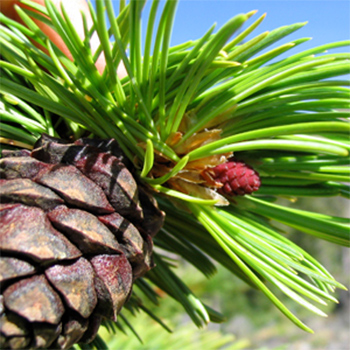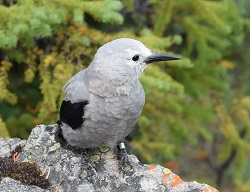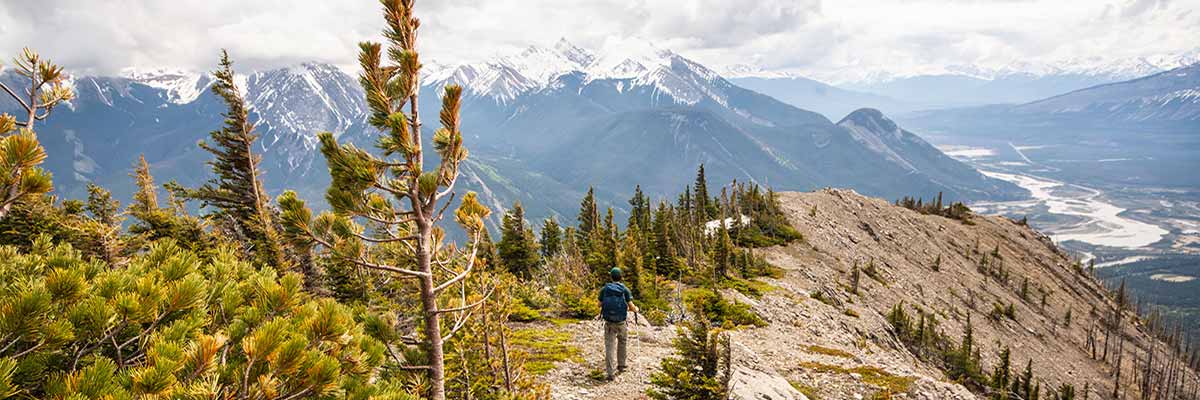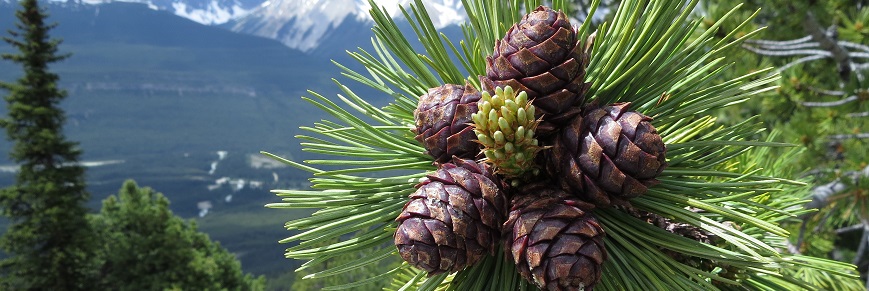
Parks Canada / Iain Reid
Whitebark pine
Jasper National Park
Quick facts
Size 5-20 metres
Cones are egg-shaped
Needles grow in clumps of 5
Lives up to 1000 years
SAR Status: Endangered (2012)

Whitebark pine trees (Pinus albicaulis) are an important species of the subalpine environment. This unique tree helps define the ecosystem by stabilizing soil, creating habitat, producing important food for animals and regulating spring water flow from the mountains.
Growing in the subalpine is not an easy task for plants: The conditions are harsh and the growing seasons are short. For whitebark pine, this means that it can take up to 30-50 years before they can produce cones; but they won’t produce them in decent quantities until they are 60-80 years old. Then to reproduce they rely completely on a bird, the Clark’s nutcracker, to spread their seeds. The Clark’s nutcracker collects whitebark pine seeds to store for food over winter. Since the birds store more seeds than they need, many are left in the ground where they will grow into new whitebark pine trees.
An important partnership

Whitebark pine depends on Clark’s nutcrackers for survival. This special relationship is called mutualism.
Whitebark pine cones are unable to open on their own and spread their seeds. Thanks to their strong curved beak, Clark’s nutcrackers are perfectly suited for this task.
Where they live
Whitebark pine in Jasper National Park grows high up on mountain slopes from about 1 500 to 2 200 metres. At these high elevations, they stand strong against harsh conditions where few other trees and plants can survive.
Whitebark pine may be rare, but they are one of the oldest tree species of the Rocky and Columbia Mountain chain. They are found in seven of Canada’s national parks: Jasper, Mount Revelstoke, Glacier, Banff, Kootenay, Yoho and Waterton Lakes.

Why they are at risk
As hardy as the whitebark pine is, it is declining throughout its range, including within the mountain national parks. It faces the many challenges brought on by white pine blister rust, mountain pine beetle, historical fire suppression and climate change. As a slow-growing tree species that relies on Clark’s nutcracker to spread its seeds, it needs our help to recover.
White pine blister rust
This introduced, invasive fungus arrived in a shipment of white pine seedlings from Europe in 1906. Less than 1% of North American trees are naturally rust-resistant.
Mountain pine beetle
Mountain pine beetle outbreaks in lodgepole pine forests are spreading to higher elevations due to climate warming. As a result, the beetles are also attacking whitebark pine.
Historic fire suppression
Older whitebark pines can survive low-intensity fires which remove competing vegetation. Habitat change due to historical practices of putting out all wildfires reduced the opportunities for seedlings to grow.
Climate change
The combined effects of climate change may decrease suitable whitebark pine habitat in the alpine.
Extreme weather events like fires and droughts have the potential to impact whitebark pine populations.
How we are helping
Cone collection and planting
We climb whitebark pine trees that show natural resistance to blister rust and put cages over their cones. These cages keep the cones away from animals that would break into them to eat their valuable seeds. When the seeds are ready in autumn, we collect them and send them to a nursery to be planted. After two years in the nursery, seedlings can be planted back in their mountain habitat or sent for rust-resistance testing.
Fire management
Whitebark pines are often shaded out by subalpine fir and spruce. The sun-loving whitebark pine thrives in recently burned areas. Fires in areas that don't pose risks to people or infrastructure may be allowed to burn with minimal to no intervention. This allows a more natural fire structure to return to the area.
Prescribed fires in whitebark pine habitat create open spaces. During prescribed fires, we protect existing stands of whitebark pine.
Research
Over the past decade, we have assessed tens of thousands of whitebark pine trees to identify several hundred trees that appear to have a natural resistance to white pine blister rust. These rare trees are tested to prove rust resistance, a process that normally takes 5 years in a controlled facility.
Mechanical thinning
Parks Canada helps whitebark pine trees in denser forests by cutting down competing species. This process mimics a prescribed fire, but without the risk of damaging whitebark pine trees. To date, we have implemented this project at Geraldine Lookout and Palisades Lookout.
Pheromone protection
Pheromones are chemicals that bark beetles use to communicate with each other. They let beetles know where they can find a mate and a place to lay eggs, or when a tree is “full” and they should try another tree.
Pheromone packets that mimic the natural pheromones of mountain pine beetles, called verbenone, are attached to whitebark pine trees to protect trees. The pheromones fool beetles into thinking that the tree is already full.
During the mountain pine beetle outbreak in Jasper National Park from 2013 to 2019, Parks Canada saved over 80% of rust-resistant whitebark pine trees from being killed by mountain pine beetle using verbenone.
Planting the Future: Saving whitebark and limber pine
Transcript
The true meaning of life is to plant trees, under whose shade you do not expect to sit
>> BRENDA: There have been a couple of whitebarkpine in the Canadian Rockies that have been aged around 1000 years old.
Sun shining through a Limber Pine tree.
I mean these trees have seen such incredible
change in the world since they were seedlings like the ones we’re planting.
Planting the Future
Woman leading a pack horse up a mountain
Whitebark and limber pine are at risk of extinction.
Seven national parks have joined forces to recover, monitor and protect these special trees.
Looking out a helicopter at Mountains and valley cloud
All of the Mountain Parks, so that’s Waterton,
Revelstoke-Glacier, Kootenay, Yoho, Banff and Jasper.
Parks Staff hiking and climbing a Whitebark Pine tree.
We all work together, we’re relying on each other trying to recover whitebark pine and
limber pine together.
Brenda Shepherd, Biologist, Jasper National Park
Whitebark pine is a pioneering species and
so it moves in and it creates, often, these little tree islands and other species are
able to move in after it.
Allison Fisher, Biologist, Yoho National Park
>> ALLISON: My favourite thing about whitebark
pine, the fact that nutcrackers are almost exclusively responsible for allowing them to regenerate.
Hilary Cameron, Biologist, Banff National Park
>> HILARY: I love that they just grow in these
really rough exposed areas and that they are so resilient and they just live for hundreds
of years.
Genoa Alger, Biologist, Waterton Lakes National Park
>> GENOA: Once we found a limber pine that
was just growing straight into a cliff, like it’s surviving and thriving.
Rebecca Smith, Biologist, Banff National Park
>> REBECCA: These trees have an absolutely
crucial role in both the plant communities and the animal communities, the soil communities,
probably more communities than we understand right now.[Laugh]
>> BRENDA: The Clark’s nutcracker and the whitebark pine have a really important relationship.
It’s called a mutualism, really rare in nature, where both species depend on each
other for their survival.
Clark's Nutcracker picks seeds out of Whitebark Pine cones.
The cones will not open on their own.
The nutcracker has a specialized beak to be able to open the cones and then it will fly
off to different parts of the forest where it will deposit seeds and then months later
Allison points to seedling from a Clark's Nutcrack cache.
they will fly back, find that exact spot and dig out the seeds and eat them.
And it’s only seeds that they don’t eat that become whitebark pine seedlings.
Rebecca walks through a stand of White bark Pines.
They evolved together, these two species,
over tens of thousands of years.
Whitebark and limber pine face many threats.
The deadliest threat is an invasive fungus called white pine blister rust.
>> ALLISON: So you can see that kind of spindle
Allison shows a diseased branch of a Whitebark tree.
shape, there’s a lot of swelling, coarse bark, and you can see some of the inactive
rust oozing out, and then this section of the branch is all dead.
>> BRENDA: These trees did not evolve with white pine blister rust and that’s what’s
really important about why this causes the tree to become endangered.
This disease came in in the early 1900’s and the tree just doesn’t have the traits
to be able to fight it off.
So we worry about these big ghost forests.
If there are ghost forests, will there not be enough whitebark pine to attract nutcrackers
and if there are no nutcrackers, there’s no future.
We climb the tree in the early summer.
We put cages on the cones, the cones mature, but they don’t get eaten by birds or squirrels.
We climb back up late September, pick the cones and then the cones dry and then we extract
the seeds from the cones.
We send those seeds to a nursery and then the nursery spends two years growing these guys.
We want to plant enough trees at a high enough
Parks Canada Staff planting trees.
density that in eighty years we will have a forest of cone producing trees that will
attract Clark’s nutcrackers back and these birds will continue to allow these stands
to persist and so that’s how we will create these self-sustaining recovered whitebark pine stands.
So there’s a lot of hope involved in keeping
a really positive attitude about what we’re doing, the fact that none of us here will
be alive to know whether this was successful.
Since 2014, Parks Canada has planted over 60,000 whitebark and limber pine seedlings in the mountain national parks. This work will continue for years to come.
Planting
| Year | Area | Seedlings |
|---|---|---|
| 2023 | Jasper National Park | 5 300Details
|
| 2022 | Jasper National Park | 3 886Details
|
| 2021 | Jasper National Park | 7 850Details
|
| 2020 | Mount Robson Provincial Park Collaboration | 800Details
|
| 2020 | Jasper National Park | 1 655Details
|
| 2019 | Jasper National Park | 3 800Details
|
| 2018 | Jasper National Park | 2 729Details
|
| 2017 | Mount Robson Provincial Park Collaboration | 4 200Details
|
| 2017 | Jasper National Park | ~ 470Details
|
Planting locations of whitebark pine seedlings in Jasper National Park
How you can help
Whitebark pine can be hard to identify. Learn to identify whitebark pine trees so you can work to protect them. Do not touch or remove any parts from whitebark pine trees. Visit our web page with essential information for residents and businesses.

Learn more
Species at risk public registry - species profile: Whitebark pine
Multi-species Action Plan for Jasper National Park of Canada (2017)
Jasper National Park Facebook LIVE - Pine in Decline
Whitebark Pine Ecosystem Foundation of Canada
The Nutcracker
The Nutcracker 2: The Second One
Parks Canada: Saving whitebark and limber pine
- Date modified :